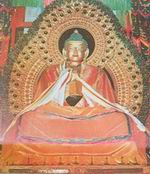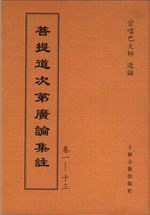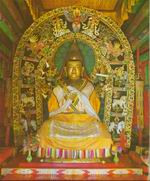Tsongkhapa was born in Tsongkha (Tsong-kha), Amdo,
in 1357, the fourth of six sons. The day after Tsongkhapa’s birth,
Chojey Dondrub-rinchen sent his main disciple to the parents with
gifts, a statue, and a letter. A sandlewood tree grew from the spot
where his umbilical cord fell to the ground. Each leaf had a natural
picture of the Buddha Sinhanada.
Tsongkhapa began to teach while in his 20s, with his first teaching
being on abhidharma (mdzod, special topics of knowledge). Everyone
was astounded at his erudition. He also began to write and do
more retreats. Soon, he had many disciples of his own. Although
some accounts say Tsongkhapa took full monk vows at age 21, it
is uncertain in which year this actually took place.
At one point, he studied and analyzed the entire Kangyur (bKa’-‘gyur)
and Tangyur (bsTan-‘gyur) – the translated direct teachings of
Buddha and their Indian commentaries. After that, at age 32, he
wrote A Golden Rosary of Excellent Explanation (Legs-bshad gser-phreng),
a commentary on Filigree of Realizations and thus on prajnaparamita.
He synthesized and discussed all twenty-one Indian commentaries.
Whatever he wrote, he substantiated with quotes from the entire
span of Indian and Tibetan Buddhist literature, comparing and
critically editing even different translations. Unlike previous
scholars, he never shied away from explaining the most difficult
and obscure passages in any text. 
Together with Lama Umapa, Tsongkhapa did an extensive retreat
on Manjushri. After the retreat, Tsongkhapa and his disciples
restored a great Maitreya statue in Lhasa, which was the first
of his four major deeds.
Tsongkhapa started The Gelug Sect in the late 14th century, following
a period of religious reform. Tsongkhap was originally a monk
of the Kargdam Sect. He went to the U-Tsang region to study the
Buddhist scriptures in 1373, and combined features of other Tibetan
Buddhist sects, such as the Sakya and Kagyu sects, in his new
doctrine. He gave equal importance to esoteric and esoteric forms
of Buddhism. Tsongkhapa strictly abided by the religious disciplines
and set a good example for his followers. To show his difference
from other monks and his determination to observe the commandments,
Tsongkhapa began to wear a yellow hat. He wrote books to explain
the Buddhist scriptures and did missionary work to spread the
spirit of Buddhism, thus earning great respect among religious
believers.
In 1409, Tsongkhapa constructed the Gandain Monastery in Dagze.
He and his disciples recruited many followers to the temple, and
formed the Gelug Sect. After the death of Tsongkhapa, his disciples
established the Zhaibung Monastery, the Sera Monastery and the
Zhaxilhunbu Monastery, as the influence of the Gelug Sect spread.
The lofty spirit and rigorous study attitude of Tsongkhapa and
his followers were highly appraised by monks of other Tibetan
Buddhist sects, and many of them converted to the Gelug Sect.
Most of the Gelug Sect monasteries were magnificent and housed
large numbers of monks and exquisite Buddhist sculptures. They
followed a strict scripture study system. The Gelug Sect grew
to be the monst influential Tibetan Buddhist sect.
|



